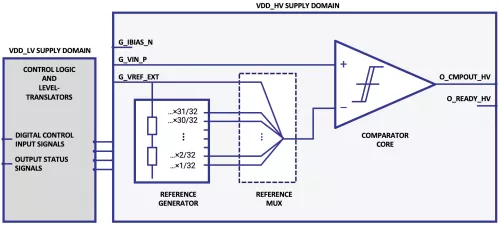agileCMP GP – Programmable-Threshold Comparator
The agileCMP GP programmable-threshold comparator features a user-selectable (enable/disable) hysteresis as well as programmable threshold with 10mV step size, a latched output as well as an active (unlatched) output. With a focus on long battery life, the agileCMP GP can be used to monitor external analog signals and enable wake-up events as is essential in many modern SoCs. The agileCMP GP programmable-threshold comparator is ideally suited for interrupt generation in applications such as in IoT, Security, Automotive, AI and general SoCs and ASICs.
Programmable Threshold Analog Comparator TSMC
Overview
Key Features
- Configurable to your specification
- Rail-to-rail input voltage range
- Low threshold offset voltage
- Programmable threshold voltage
- Programmable hysteresis
- Dynamic and static (latched) outputs
- Low propagation delay
Benefits
- Best-in-class deliverables for easy and seamless integration: our engineers have extensive experience taking complex SoCs from design to mass production
- We believe that success is not just measured by delivery of netlist and layout, rather it extends to mass-production and beyond
- Automated design procedure accelerates design time and enables quick re-centering with latest PDK updates so you can tape out with the latest foundry models
- Tried and tested architecture ensures reliability and functionality
Block Diagram

Applications
- IoT, Security, Automotive, AI, SoCs, ASICs
Deliverables
- Datasheet
- Testing and Integration Guide
- Verilog Models
- Floorplan (LEF)
- Timing models (LIB)
- Netlist (CDL)
- Layout (GDS)
- Physical Verification Report
- Design Report
Technical Specifications
Foundry, Node
TSMC
Maturity
Available on request
Availability
Now
TSMC
Pre-Silicon:
3nm
,
4nm
,
5nm
,
6nm
,
7nm
,
10nm
,
12nm
,
16nm
,
20nm
,
22nm
,
28nm
,
28nm
HP
,
28nm
HPC
,
28nm
HPCP
,
28nm
HPL
,
28nm
HPM
,
28nm
LP
,
40nm
G
,
40nm
LP
,
45nm
GS
,
45nm
LP
,
55nm
FL
,
55nm
G
,
55nm
GP
,
55nm
LP
,
55nm
NF
,
55nm
ULP
,
55nm
ULPEF
,
55nm
UP
,
65nm
G
,
65nm
GP
,
65nm
LP
,
80nm
,
80nm
GT
,
80nm
HS
,
85nm
,
90nm
FS
,
90nm
FT
,
90nm
G
,
90nm
GOD
,
90nm
GT
,
90nm
LP
,
90nm
zzz
,
110nm
G
,
110nm
HV
,
110nm
LVP
,
130nm
,
130nm
BCD
,
130nm
BCD+
,
130nm
G
,
130nm
LP
,
130nm
LV
,
130nm
LVOD
,
150nm
G
,
150nm
LV
,
160nm
G
,
160nm
LP
,
180nm
,
180nm
E
,
180nm
ELL
,
180nm
FG
,
180nm
G
,
180nm
LP
,
180nm
LV
,
180nm
ULL
Related IPs
- Programmable Threshold Analog Comparator GlobalFoundries
- Programmable Threshold Analog Comparator on Samsung
- Programmable Threshold Analog Comparator UMC
- Programmable Threshold Analog Comparator SMIC
- Programmable Threshold Analog Comparator Intel
- Analog comparator for 3.6V supply and PMOS type input designed in 0.18um 6M TSMC technology